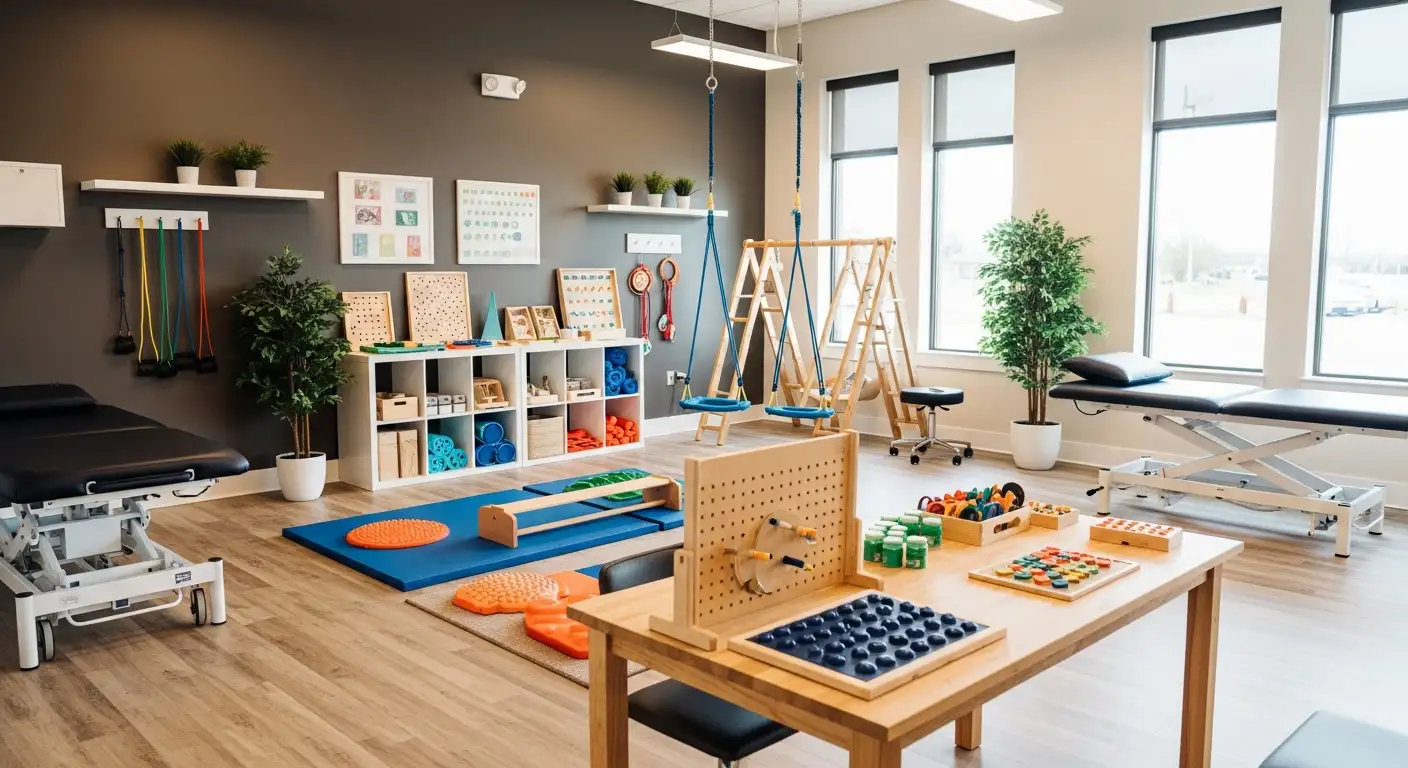The Role of Occupational Therapy in Improving Daily Living Skills


Understanding the Impact of Occupational Therapy
Occupational therapy (OT) plays a crucial role in helping individuals, especially children with developmental challenges such as autism spectrum disorder (ASD), gain the skills necessary for independent living. By targeting specific areas like fine and gross motor skills, sensory processing, and self-care abilities, occupational therapy fosters improvements that significantly enhance daily functioning and quality of life. This article explores the multifaceted approach of OT, its integration with other therapeutic disciplines, and its profound impact on daily living skills across diverse populations.
Defining Therapy-Related Fields Within the Broader Therapeutic Spectrum

What are the therapy-related fields included in the collective term for these therapies?
The collective term for therapy-related fields covers a diverse range of approaches designed to improve mental, emotional, and physical well-being. These include behavioral therapy, cognitive-behavioral therapy (CBT), psychodynamic therapy, humanistic therapy, physical therapy, occupational therapy, speech therapy, counseling, and nutrition therapy.
Behavioral therapy and CBT focus on changing behaviors and thought patterns. They often use techniques like desensitization or rational-emotive methods to help people manage issues such as anxiety or behavioral challenges. Psychodynamic therapy delves into unconscious psychological processes, aiding in the treatment of mood disorders like depression and anxiety by exploring past experiences and internal conflicts.
Humanistic therapy centers on raising self-awareness and promoting personal growth. This approach often supports individuals dealing with low self-esteem or trauma by encouraging emotional expression and self-acceptance.
In contrast to psychological therapies, physical therapy, occupational therapy, and speech therapy primarily address physical functioning and daily living skills. Physical therapy improves gross motor skills, muscle strength, balance, and mobility through targeted exercises and adaptive activities. Occupational therapy focuses on self-care, fine motor skills, sensory integration, and social participation, especially crucial for those with developmental disabilities. Speech therapy assists in communication development, targeting articulation, language skills, and social interaction abilities.
Each therapy type employs unique methods reflecting its goals. Psychological therapies often utilize talk-based and cognitive techniques, while physical and occupational therapies rely on hands-on activities and customized exercises. Speech therapy combines language intervention and motor skill training to support effective communication.
Together, these therapy-related fields create a holistic support system that addresses the emotional, cognitive, and physical needs of individuals, tailored to their specific challenges and life goals.
The Core Focus of Occupational Therapy in Daily Living

What role does occupational therapy play in improving self-care and daily task management?
Occupational therapy (OT) is pivotal in helping children, especially those with developmental disabilities like autism, manage essential self-care and daily living tasks. Therapists focus on activities such as toileting, feeding, dressing, and other personal care routines to promote independence and enhance quality of life.
How does OT enhance fine and gross motor skills?
OT targets both fine and gross motor skill development. Fine motor skills, including hand-eye coordination and dexterity, are sharpened to help children with tasks like writing or using utensils. Gross motor skills improvement involves activities that boost muscle strength and coordination, facilitating movements such as walking, running, or playing.
How are sensory processing challenges addressed in occupational therapy?
Children with sensory processing difficulties benefit significantly from OT through sensory integration therapy. Occupational therapists design personalized sensory diets—customized sensory experiences tailored to each child’s needs—that aim to improve focus, emotional regulation, and adaptive behavior.
What tools and adaptive equipment are utilized in occupational therapy?
OT often employs a range of adaptive tools to support daily living skills. This includes specialized feeding utensils for easier eating, switches for controlling devices, splints to assist with hand positioning, and adapted clothing to simplify dressing. These tools empower children to perform tasks more independently.
How does OT contribute to play, work-related abilities, and social participation?
Beyond physical skills, occupational therapy supports social participation by enhancing communication abilities and facilitating social skills training. Therapists also assist children in developing play and work-related competencies, fostering confidence and participation in meaningful activities essential for their development and integration.
| Focus Area | OT Intervention | Benefits |
|---|---|---|
| Self-care & daily tasks | Training in toileting, feeding, dressing | Promotes greater independence and self-sufficiency |
| Motor skills | Fine motor activities, gross motor strengthening | Improved coordination and mobility |
| Sensory processing | Sensory integration therapy, personalized sensory diets | Enhanced focus, emotional regulation, and adaptive responses |
| Adaptive tools & equipment | Feeding utensils, switches, splints, clothing adaptations | Facilitates easier performance of daily tasks |
| Social & play skills | Communication enhancement, social training | Encourages social interaction and participation in play and work |
Occupational Therapy’s Role in Supporting Children with Autism Spectrum Disorder

Sensory integration therapy as a key OT approach for autism
Occupational therapy (OT) frequently utilizes sensory integration therapy to help children with autism spectrum disorder (ASD) manage sensory processing challenges. This approach aims to improve how children respond to sensory inputs, making daily experiences less overwhelming and more manageable.
Designing personalized sensory diets to aid focus and behavior
OTs create customized sensory diets tailored to each child's unique sensory needs. These sensory diets involve structured activities and environmental adjustments that support better focus, attention, and behavioral regulation, crucial for enhancing learning and social participation.
Improving communication and social skills through OT
Beyond sensory processing, occupational therapy also targets communication and social skills development. By incorporating social skills training and communication strategies, OTs help children improve interaction abilities and engage more comfortably with peers and family.
Managing sensory overload and promoting self-regulation
OT helps children with ASD manage sensory overload by teaching self-regulation techniques. These strategies enable children to identify sensory triggers and use calming methods, fostering emotional control and reducing anxiety or disruptive behaviors.
Impact of early intervention occupational therapy on children with ASD
Early intervention with occupational therapy can significantly boost children's development. Introducing OT at a young age enhances fine motor skills, self-care, communication, and social participation, supporting greater independence and an improved quality of life over time.
Integration of Occupational Therapy with Other Therapeutic Disciplines

How does occupational therapy collaborate with speech therapy and physical therapy?
Occupational therapy (OT) works closely with speech therapy and physical therapy to create a comprehensive support system for children with autism and developmental disabilities. While OT focuses on improving self-care, fine motor skills, sensory processing, and daily living activities, speech therapy addresses communication challenges such as articulation, language development, and social interactions. Physical therapy targets gross motor skills, balance, and mobility issues. Together, these therapies coordinate to reinforce skills that overlap, such as oral motor functions important for feeding (OT and speech therapy) and body strength supporting motor tasks (OT and physical therapy).
How are behavioral interventions like ABA incorporated with occupational therapy?
Behavioral interventions such as Applied Behavior Analysis (ABA) are frequently integrated with occupational therapy to enhance developmental outcomes. ABA provides structured, evidence-based behavior modification techniques for communication and independence skills. OT complements this by addressing sensory integration, self-regulation, and fine motor abilities. Many programs combine ABA strategies with OT techniques to promote adaptive living skills like toileting, feeding, and social participation, ensuring that behavioral improvements are supported by functional skill development.
Why are multidisciplinary approaches important for comprehensive support?
Children with autism benefit most from multidisciplinary approaches because they address the diverse challenges faced across physical, communicative, and behavioral domains. Coordinated efforts among therapists enable individualized intervention plans that encompass sensory processing, communication, motor skills, and behavioral management. This integrated care maximizes each child's ability to gain independence and thrive in daily life by targeting all areas impacting function and participation.
How does caregiver training and family involvement enhance therapy plans?
Caregiver training and family support form essential components of effective therapeutic programs. Therapists actively educate families on implementing strategies at home, ensuring consistency and reinforcing skill acquisition outside of clinical settings. Family involvement also helps tailor therapy goals to everyday routines and cultural contexts, enhancing the practicality and sustainability of gains in behavior, communication, and daily living skills.
How does this integration support holistic development of daily living and adaptive skills?
By combining occupational therapy's focus on sensory integration and self-care with speech therapy's communication enhancement, physical therapy's motor improvements, and ABA's behavioral support, children receive well-rounded assistance. This holistic approach fosters critical adaptive skills such as feeding, toileting, socialization, and communication, which are vital for independence and quality of life. Integrating these therapies ensures children's developmental needs are met comprehensively, promoting functional abilities needed across all environments.
Applied Behavior Analysis (ABA) Therapy: Enhancing Independence Skills

What role does ABA play in improving communication, social skills, and behavior?
ABA therapy is a widely used intervention for children with autism and developmental disabilities. It focuses on enhancing essential skills like communication and social interactions while reducing challenging behaviors. Programs are carefully designed to promote positive behavioral changes that support everyday functioning.
What structured approaches are used in ABA?
Two main evidence-based methods within ABA include Naturalistic Environment Teaching (NET) and Discrete Trial Training (DTT). NET teaches skills in naturally occurring settings to encourage generalization, while DTT uses structured, repetitive teaching sessions for mastering specific tasks.
How is ABA applied across different age groups?
ABA programs serve individuals across the lifespan, from early intervention in infants and toddlers to adult services. This broad applicability allows tailored support for developmental stages, ensuring continuous growth and skill acquisition.
Does ABA address adaptive living skills like toileting and feeding?
Yes, many ABA programs incorporate training in adaptive living skills. Critical areas such as toileting and feeding are often targeted to foster independence and improve quality of life.
How does ABA incorporate caregiver training and family support?
Caregiver involvement is fundamental in ABA therapy. Providers frequently offer caregiver training and family support to enhance practical skill development and ensure strategies are consistent and functional in everyday environments.
Speech Therapy’s Complementary Role in Developing Communication Skills

How does speech therapy support articulation and language development?
Speech therapy assists children with challenges in talking, forming complete sentences, or being easily understood. Techniques include language intervention activities, articulation therapy to clarify speech sounds, and oral motor exercises. This tailored approach helps improve speech clarity and language skills necessary for effective communication.
What speech challenges does therapy address?
Therapy targets issues such as unclear articulation, use of baby talk, and difficulties with social communication. Children who struggle to express themselves or engage socially can benefit from structured speech therapy designed to foster better verbal interactions.
How is augmentative and alternative communication (AAC) incorporated?
AAC methods complement traditional speech therapy, providing children with communication alternatives when verbal speech is limited. Tools may include picture exchange systems, communication boards, or speech-generating devices, enabling enhanced interaction and reduced frustration.
How does speech therapy integrate with occupational therapy?
Integration is common as speech therapy complements occupational therapy's focus on fine motor skills and sensory processing. Together, they create a holistic approach that supports overall communication abilities and daily functioning, promoting independence.
What is the typical frequency and structure of speech therapy sessions?
Therapy is usually scheduled 1-2 times per week, with session lengths around 30 to 45 minutes. These sessions are tailored to each child's individual needs and progress, ensuring targeted and effective treatment plans.
Physical Therapy: Enhancing Gross Motor Skills and Mobility
What Does Physical Therapy Focus On?
Physical therapy aims to improve muscle strength, gross motor skills, balance, and coordination for children experiencing physical challenges. It is especially beneficial for those with muscle weakness, abnormal muscle tone, or limited joint mobility.
Which Therapeutic Activities Are Used?
Physical therapists use diverse activities and tools to support progress. Common methods include aquatic therapy, treadmill and gait training, and robotics-assisted movement exercises. These techniques help children build strength and enhance mobility in engaging ways.
How Does Physical Therapy Support Children with Physical Challenges?
For children with abnormal muscle tone or limited joint mobility, physical therapy provides tailored exercises and adaptive equipment designed to increase range of motion and improve functional movement. This individualized approach helps overcome barriers to mobility.
How Does Physical Therapy Differ from Occupational Therapy?
While physical therapy primarily targets gross motor functions, occupational therapy focuses on daily living skills such as self-care, play, and fine motor coordination. Together, they provide a comprehensive approach to support a child’s independence and overall development.
How Do Improvements in Mobility Impact Daily Living?
As physical therapy enhances strength, balance, and coordination, children gain greater independence in activities such as walking, playing, and participating in school. These mobility improvements contribute significantly to their ability to engage in daily routines and meaningful activities.
Adaptive Tools and Techniques in Occupational Therapy for Daily Functioning
Examples of adaptive equipment used in Occupational Therapy
Occupational therapists often use specialized equipment to boost daily functioning. Examples include adaptive feeding utensils designed for easier grip and control, switches that assist with activating devices, splints to support joint stability, and clothing adaptations that simplify dressing tasks. These tools help children gain greater independence in eating, dressing, and other everyday activities.
Techniques such as sensory diets and visual supports
Personalized sensory diets are crafted to provide tailored sensory input that supports self-regulation, focus, and behavior. Visual supports, such as picture schedules or visual cues, assist in understanding routines and instructions, enhancing communication and task completion.
Personalized interventions for eye-hand coordination and visual perception
Therapy targets improving eye-hand coordination and visual perception through activities like tracing, puzzles, and manipulation tasks. These interventions help develop fine motor skills critical for writing, using utensils, and engaging in play.
Role in improving handwriting and social skills training
Occupational therapy includes handwriting improvement techniques involving proper pencil grip and letter formation practice. Social skills training within OT supports interaction abilities, fostering better communication and participation in peer activities.
Enhancing self-efficacy and independence through tailored adaptations
By combining adaptive tools and customized techniques, occupational therapy empowers children to perform self-care and functional tasks efficiently. This approach nurtures confidence and autonomy, improving overall quality of life and fostering lifelong independence.
The Significance of Early Intervention in Occupational Therapy

Benefits of Initiating OT at an Early Age for Developmental Gains
Early occupational therapy (OT) plays a pivotal role in improving essential skills for children, particularly those with autism spectrum disorder (ASD). Starting OT early can enhance fine and gross motor skills, sensory processing, and self-care abilities, thereby promoting developmental progress that forms a strong foundation for future learning and daily functioning.
How Early OT Interventions Promote Long-Term Independence
By addressing sensory integration, communication, and social participation early on, OT supports children's ability to manage daily tasks independently. Techniques like sensory integration therapy and creating personalized sensory diets help children regulate attention and behavior, which directly contribute to their self-efficacy and long-term autonomy.
Interaction with Early Childhood Educational Settings
Early interventions are often integrated with early childhood education programs, fostering a supportive environment where therapy goals align with classroom activities. This holistic approach ensures children can apply newly developed skills in social and educational contexts, enhancing their participation and inclusion.
Support for Families in Early Developmental Stages
Occupational therapists not only work with children but also provide guidance and training to families. This support helps caregivers implement effective strategies at home, creating consistency in developmental efforts which is crucial during the early growth stages.
Case Examples of Progress Through Early Intervention
Children receiving early OT have shown notable improvements in managing sensory challenges, developing self-care routines, and increasing social interactions. These gains often translate into better academic readiness and improved quality of life, demonstrating the profound impact of early therapeutic engagement.
Therapy Delivery Settings and Frequency

What are the different delivery models for ABA therapy?
ABA therapy is offered through several delivery models to best meet the child's needs. Common settings include in-home services, which allow therapy within the child's natural environment, clinic-based sessions conducted in specialized facilities, and center-based programs providing a structured classroom atmosphere. Each setting offers unique benefits, providing tailored approaches from personalized 1:1 interventions to group skill-building activities.
How frequently and for how long are therapy sessions typically conducted?
Therapy session frequency usually ranges from one to two times weekly, with individual sessions lasting about 30 to 45 minutes. These durations allow for focused, manageable intervals of learning and skill development without overwhelming the child.
How is therapy intensity customized?
The intensity of therapy is carefully tailored to each child's specific needs, considering developmental status, behavioral challenges, and family circumstances. For example, full-time ABA therapy involves a dedicated one-on-one therapist and a classroom environment emphasizing intensive skill development. This contrasts with developmental preschools, which provide broader but less intensive educational experiences.
Why is ongoing evaluation important in therapy?
Continuous assessment ensures therapy plans remain effective and responsive to the child's progress. Ongoing evaluation allows for adjustments in session frequency, therapy techniques, and delivery settings to optimize outcomes over time.
This flexible approach to therapy delivery and scheduling enables providers to maximize developmental gains, adapt to changing needs, and support children with autism in achieving greater independence and improved daily functioning.
Caregiver and Family Involvement in Therapy Outcomes

Training caregivers to reinforce skills at home
Caregiver training is a fundamental part of therapy programs, especially in ABA. Therapists work closely with families to teach them how to apply behavioral strategies and reinforce new skills outside formal sessions. This consistent reinforcement at home significantly accelerates children's progress and generalizes skills to everyday settings.
Family support as a critical component in therapy success
Family involvement extends beyond training; emotional and practical support for caregivers is vital. Providers often offer resources and guidance to help families manage challenges, stress, and behavioral issues, fostering a more nurturing environment that supports therapeutic gains.
Encouraging functional and practical skills development beyond therapy sessions
Therapies emphasize functional, real-life skills such as toileting, feeding, and communication. Caregivers learn to integrate these practical skills into daily routines, ensuring that children strengthen independence and apply what they learn in therapy to their everyday lives.
Building routines that incorporate learned skills
Creating structured routines that weave in learned behaviors and skills helps children maintain consistency and predictability. Families receive guidance on how to design such routines that promote self-care, social interaction, and adaptive behaviors effectively.
Emotional and behavioral development through family-centered approaches
Family-centered therapy approaches address emotional and behavioral development by supporting parents in managing tantrums, attention issues, and communication struggles. These approaches emphasize collaboration, ensuring that the child's progress is supported across all environments through shared strategies and understanding.
The Holistic Goal: Enhancing Quality of Life Through Occupational Therapy

How Does Occupational Therapy Impact Emotional, Behavioral, and Functional Development?
Occupational therapy (OT) is pivotal in supporting children with autism and developmental delays by addressing sensory processing challenges and enhancing self-care and motor skills. Through sensory integration therapy, occupational therapists help improve self-regulation and focus, which positively influences emotional and behavioral development.
In What Ways Does OT Foster Self-Efficacy and Independence in Daily Activities?
OT promotes independence by improving fine motor skills, communication abilities, and daily living tasks such as feeding and toileting. Tailored strategies and adaptive tools enable children and adults to manage these essential activities confidently, reinforcing their autonomy.
How Are Therapy Gains Integrated Into Community and Social Participation?
Occupational therapists incorporate social skills training and visual supports to help individuals apply learned skills in real-world settings. This integration facilitates meaningful participation in play, work, and social environments, expanding their engagement beyond therapy sessions.
What Are the Long-Term Benefits of Occupational Therapy for Developmental Delays?
Early and consistent OT intervention enhances quality of life by fostering lifelong skills in self-care, sensory processing, and communication. These gains contribute to improved independence, emotional well-being, and better adaptation to daily challenges throughout childhood and into adulthood.
Why Is Occupational Therapy Considered a Critical Partner in Lifelong Learning and Adaptation?
OT supports continuous development by adapting interventions as individuals grow, addressing evolving needs related to sensory integration, motor function, and social participation. This adaptability ensures sustained progress and adaptation to new life stages and environments.
Integrating Occupational Therapy for Lifelong Independence
Occupational therapy stands as a vital component in the spectrum of therapies designed to improve daily living skills across lifespans, particularly for individuals with autism and developmental challenges. Its tailored interventions addressing motor skills, sensory processing, and self-care, combined with collaborative efforts alongside ABA, speech, and physical therapies, underscore a comprehensive approach to fostering independence. Early intervention, adaptive tools, and family involvement further amplify its benefits, ultimately enhancing the quality of life and promoting meaningful participation in everyday activities for those undergoing therapy.
References
Recent articles

How Speech Therapy Assists with Comprehending Complex Sentences
Unlocking Language Potential: The Role of Speech Therapy in Mastering Complex Sentences

Medication for Autism
Understanding the Role of Medication in Autism Spectrum Disorder Management

The Importance of Handwriting Development in Occupational Therapy
Handwriting Skills: A Critical Focus in Pediatric Occupational Therapy

Aba Therapy Age Limit
Understanding the Age Range and Effectiveness of ABA Therapy

Aba Therapy Age Limit
Exploring the Age Spectrum for Effective ABA Therapy Intervention

Facial Grimacing in Autism
Understanding Nonverbal Expressions in Autism Spectrum Disorders


